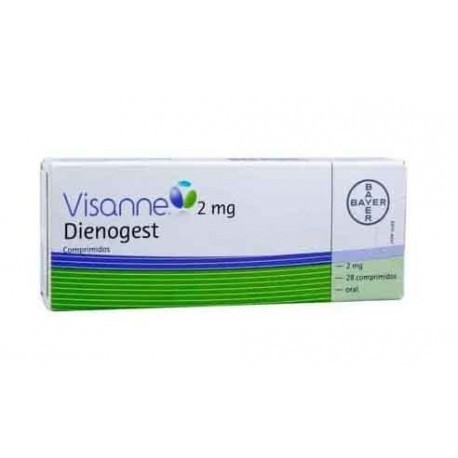 View larger
View larger Visanne (dienogest) 2 Mg 28 Tablets
VSNN8130
New product
BUY MORE PAY LESS
| Quantity | Discount | |
|---|---|---|
| 2 | 5% | |
| 3 | 10% | |
| 4 | 15% | |
| 5 | 20% |
Volume discounts
| Quantity | Discount | You Save |
|---|---|---|
| 2 | 5% | Up to $4.90 |
| 3 | 10% | Up to $14.70 |
| 4 | 15% | Up to $29.40 |
| 5 | 20% | Up to $49.00 |
More info
VISANNE 2 mg tablet Taken orally.
Active ingredient
Each tablet contains 2 mg of dienogest.
Excipients
Lactose monohydrate, starch, microcrystalline cellulose, povidone K 25, talc, crospovidone, magnesium stearate.
1.What is VISANNE and what is it used for?
• VISANNE packaging contains 28 tablets of white to whitish color, round, flat surface, conical edge. Each tablet contains 2 mg of dienogest active ingredient.
• VISANNE is a hormone drug. Its active ingredient, dienogest, belongs to a group of drugs called progestogens.
• VISANNE is used for the treatment of a condition called endometriosis. Endometriosis is the name given to the lining of the uterus (endometrium) in a place other than the inner surface of the uterus.
The inner layer of the uterus thickens every month in the course of the menstrual cycle and then is expelled out of the body by the menstrual bleeding mechanism.
The endometrium tissue in the extrauterine areas thickens in the same way, but cannot be thrown out of the body during bleeding periods and causes inflammation and pain in the area where it is located.
VISANNE prevents the development of this tissue and reduces pain in the lower abdomen (hip) area of the lower abdomen and painful menstrual bleeding, which are seen in endometriosis disease.
Endometriosis treatment is a long-term treatment. VISANNE where menstrual bleeding begins
It can be used between the period and the period it ends (menopause).
2.How to use VISANNE?
Instructions for appropriate use and dose / frequency of administration
Always take VISANNE exactly as your doctor has told you. If you are unsure, you should ask your doctor or pharmacist.
Take care to follow the advice given below; otherwise, your medicine may not work properly.
You should take 1 tablet a day.
Use the tablets continuously, including on days with menstrual bleeding. When one box is finished, start another box without a break. VISANNE is for long term use.
Application route and method
Take VISANNE preferably at the same time of the day with a sufficient amount of liquid as needed. You can take VISANNE alone or with food. You can start taking the tablet on any day of the cycle.
Different age groups
Use in children
It should not be used before starting menstruation. 18 with first menstruation
Its use between the ages has not been evaluated.
Use in the elderly
Use in the elderly
Special use cases
Renal insufficiency: Dose adjustment is not required in patients with renal insufficiency. Liver failure: Visanne should not be used if there is a past or current serious liver disease.
If you have the impression that the effect of VISANNE is too strong or too weak, talk to your doctor or pharmacist.
If you use more VISANNE than you should
Talk to a doctor or pharmacist if you have used more than you should use from VISANNE.
Based on the studies conducted, serious harmful effects from overdose are not expected.
If you forget to use VISANNE
If you forget to take one or more tablets, take your tablet as soon as you remember. Continue to take your medicine at the usual time for the following days. Do not take two doses on the same day.
Recommendations in case of gastrointestinal disorders:
If you vomit or have diarrhea within 3-4 hours after taking Visanne, you should take another tablet as soon as possible.
3. What are the possible side effects?
Like all medicines, there may be side effects in people who are sensitive to the substances contained in Visanne.
These side effects are more common in the first months after starting Visanne treatment and usually disappear with continued treatment. There may also be changes in your bleeding patterns, eg. blotchy bleeding, irregular bleeding or no menstruation.
Possible side effects are listed below according to their frequency.
Frequency of side effects listed below Very common (> 1/10); common (1/100 to <1/10); uncommon (1/1000 to <1/100); rare (> 1 / 10,000 to <1/1000); very rare (<1 / 10,000) based on data obtained from clinical studies.
Blood and lymphatic system disorders
Uncommon: Anemia
Metabolism and nutrition disorders
Common: Weight gain
Uncommon: weight loss, increased appetite
Psychiatric illnesses
Common: Depressed mood, sleep disturbances, irritability, loss of sexual desire, mood swings
Uncommon: Tension, depression, mood swings
Nervous system disorders
Common: Headache, migraine
Uncommon: Autonomic nervous system imbalance (this system controls body functions that occur spontaneously, e.g. heartbeats, sweating, gastrointestinal movements, etc.), disturbance in attention
Eye diseases
Uncommon: Dry eye
Ear and labyrinth disorders
Uncommon: Tinnitus
Heart diseases
Uncommon: Nonspecific circulatory system disorders, palpitations
Vascular diseases
Uncommon: low blood pressure

